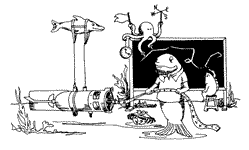
|
The IEEE Seventh Working Conference on Current Measurement TechnologyCurrent and Wave Monitoring and Emerging TechnologiesMarch 13-15 | Bahia Hotel | San Diego, CA, USA |
||
|
Technical Program Accomodations Order the Proceedings Committee and Contact Info |
||
The application of ADCP to the measurement of current system at the hydrothermal active areasKyohiko MitsuzawaJAMSTEC Seattle Office Direct current measurement in hydrothermal area is one of the important factors to understand the hydrothermal system. The application of ADCP is effective to measure the current system. The ADCP (RDI Workhorse Sentinel 300kHz) was attached on the JAMSTEC/Deep Tow Sonar, the manned submersible “Shinkai 2000” and deployed at seafloor using ROV during a few scientific cruises at the hydrothermal active areas in the western Pacific. The JAMSTEC/Deep Tow Sonar was carried out to survey for precise topographic at the hydrothermal area in the southern Mariana Trough in January 2000. During the survey, the ADCP was attached in the sonar with down looking. It is towed about 80-120m above the seafloor. In this observation, acoustic scatterings were to small to measure over 30m range, in addition vertical component was difficult to measure depending on the heaving effect from the ship. It is necessary to reduce heaving motion at towed fish such as using sub-fish system that is separated from main-fish via a second cable. In the hydrothermal area of the Okinawa Trough, which were known as several active hydrothermal area with huge chimneys as temperature of over 230°C, current measurement by ADCP was carried out using the manned submersible “Shinkai 2000” in June 2000. ADCP was mounted down looking on the “Shinkai 2000” as a payload. The “Shinkai 2000” was operated with 0.3-0.5kts keeping its depths from 870m to 900m. In this observation, it was obtained the current profile as about 100m range. As a result of measurement, over 20cm /sec of upwelling was measured in the hydrothermal active area. In this area, ADCP was deployed for 23 hours as up looking at beside of the hydrothermal chimney. It was settled and recovered by the ROV “Dolphin 3K” in June 2000. Bottom current was changed in about half a day period depending on tide. However, in half period of the observation, acoustic scattering signal is too small to measure over 30m range. Measurement conditions depending on the water column, water column contained with hydrothermal fluid has enough particles for acoustic scattering; however the standard deep water of this area is too clear to obtain the enough acoustic scattering. During measurable period, upwelling was measured as current speed of about 20cm/sec. Submitted on January 22, 2003 |
|
Sponsored by the Current Measurement Technology Committee (CMTC) of the IEEE Oceanic Engineering Society. All content reserved. Contact jrizoli@whoi.edu for more information. |
||